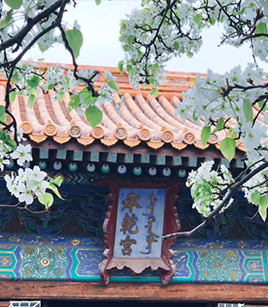A lunar year with two ‘Beginnings of Spring’

Flowers bloom in Beijing's Palace Museum in spring. Photo: Ren Guanhong/CSST
by Ren Guanhong
According to the Chinese lunar calendar, the Guimao Year and the Chinese zodiac Year of the Rabbit roughly correspond to the Gregorian calendar year 2023. What makes the Guimao Year special is that there are two “Lichun,” or “Beginning of Spring” dates [the first solar term of the 24 solar terms] within this lunar year, one falling on February 4, 2023, the fourteenth day of the first lunar month, and the other on the same date in 2024, the twenty-fifth day of the twelfth lunar month. Hence, the Guimao Year is also called “Shuangchun Nian” [lit. the double-spring year].
This special phenomenon is caused by the insertion of the “Run Eryue,” or the “Leap Month.” A solar year of the Gregorian calendar, based on the revolution of the earth around the sun, is either 365 days or 366 days. The twenty-four solar terms are also based on the observation of the sun’s annual motion, so they are consistent with the Gregorian calendar in a sense, with relatively fixed dates in a solar year. Since it takes the moon about 29.5 days to complete one cycle of phases, there is approximately 354 days in a lunar year. This leaves an 11-day difference between one solar year and one lunar year. Therefore, under the 19-year cycle, the ancient Chinese added a leap month to the Chinese lunar calendar seven times in each cycle to ensure that both the lunar and solar calendars are synchronized. A lunar year with a leap month can be as long as 384 or 385 days. In the Chinese lunar calendar, the leap month takes the same number as the preceding month. For example, if it follows the second month then it is simply called the “leap second month.”
The leap month occurs every two or three years and the Year of the Rabbit is one such year. It starts on Jan 22, 2023 and ends on Feb 9, 2024, involving two “Beginnings of Spring” at the beginning and the end of the year.
Edited by BAI LE

 PRINT
PRINT CLOSE
CLOSE